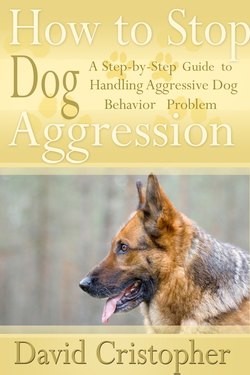Читать книгу How to Stop Dog Aggression: A Step-By-Step Guide to Handling Aggressive Dog Behavior Problem - David CDN Christopher - Страница 6
На сайте Литреса книга снята с продажи.
Do You Have an Aggressive Dog?
ОглавлениеSince you have picked up this book, you probably either know or suspect that your dog might be aggressive.
However, since dogs can play rough, is your dog really being aggressive or is the dog just burning off extra energy?
Dogs are pack animals and like all pack animals, there is an alpha dog, the pack leader. If you let the dog feel like he is the pack leader, it can lead to aggressive behavior because the dog will feel that what he says goes.
Even an occasional sign of aggression is not to be treated lightly because left untended to; it can become a big problem.
Fixing your dog’s aggression now is the best way to handle it.
Our methods will help if your dog is already aggressive or just starting to show signs.
Dog aggression is not going to be a fast fix, you will need to invest time, energy, and patience into curing aggression, but this is your dog, your companion and he is your responsibility.
We applaud you for wanting to help your dog instead of giving up on him.
By working with him, you can cure the aggression, get your loving companion back, and not have to worry about any possible problems.
Never be aggressive with your dog, no yelling or physical punishment. Moreover, if you have a dog with aggressive tendencies then do not encourage play-aggression.
Here are some of the behaviors that an aggressive dog will exhibit:
Curled lips or baring their teeth
Growling
Snarling
Snapping at people or other dogs
Lunging at people or other dogs
Biting – even lightly biting where the skin is not broken is still an act of aggression
Barking excessively
Blocking the way of somebody or another dog
If your dog’s behavior causes you to worry or feel anxious, then you are likely dealing with an aggressive dog.
You should not fear your own dog, and if you do, your dog will sense that and use it to his advantage.
Remember, you should be the pack leader, not your dog and your dog will sense your fear and use it to establish himself as the dominate dog in the household.
Training for aggressive dogs will help establish or re-establish that you are the alpha dog, the pack master and the dominate one in the house.
You deserve the peace of mind that your pet will not cause harm and we will give that back to you.
If you have a dog that growls excessively, perhaps when you play with them or even during dinnertime they will growl.
That is aggressive dog behavior and should not be encouraged. Sure, it is cute when you are play fighting with your puppy and they give their little growls but that just teaches them that growling is okay, and it is not so cute when an adult dog does it.
With training, you can teach your dog that growling when unnecessary or growling excessively is not allowed and that it will not be allowed to get away with it.
Biting is an outright act of aggression. A dog can bite out of fear, if you reach towards a dog who is exhibiting signs of fear; you are likely to get bit.
Biting, even lightly is not to be tolerated and training to stop biting should begin immediately.
A dog that bites once is very likely to bite again, but you do not have to give up your dog!
Training will usually help cure your dog of their biting habit.
Some triggers for aggressive behavior:
Somebody walks by the dog while the dog is eating or another animal gets too close to the food bowl
Trying to retrieve food that was dropped on the floor
Trying to retrieve food that a dog has taken from the table, plate or counter
Attempting to get a dog to stop taking trash from the trash can
When somebody enters the room the dog is in
Walking too close to the dog’s bed
Trying to pull a fearful dog out from under a bed or from a closet
Handling the dog
Somebody roughhouses with the dog
The dog is being teased by somebody
Pulling the dog’s tail or their ears
Attempting to retrieve something that the dog has that it shouldn’t (a shoe or slipper perhaps)
If somebody takes one of the dog’s toys, or another animal takes one of the dog’s toys
Somebody approaches the front door that the dog does not know
Follows or chases strangers that are in the yard, such as delivery people or mailman
Snapping or lunging at people in the yard or house
Whenever a stranger approaches
Seeing another dog or animal
Being handled by anybody other than the owner, or even their owner
Chasing things – cars, bikes, skateboards
Standing over a sleeping dog, or hovering over a sitting dog
Waking up a sleeping dog
Trying to put on a collar or harness
Trying to get the dog either in or out of the car
Attempting to medicate the dog
Moving the dog from a place in the house it is not supposed to be
Sudden movement made around the dog
Something loud scares the dog – fireworks, thunder, car backfires, loud motorcycle
